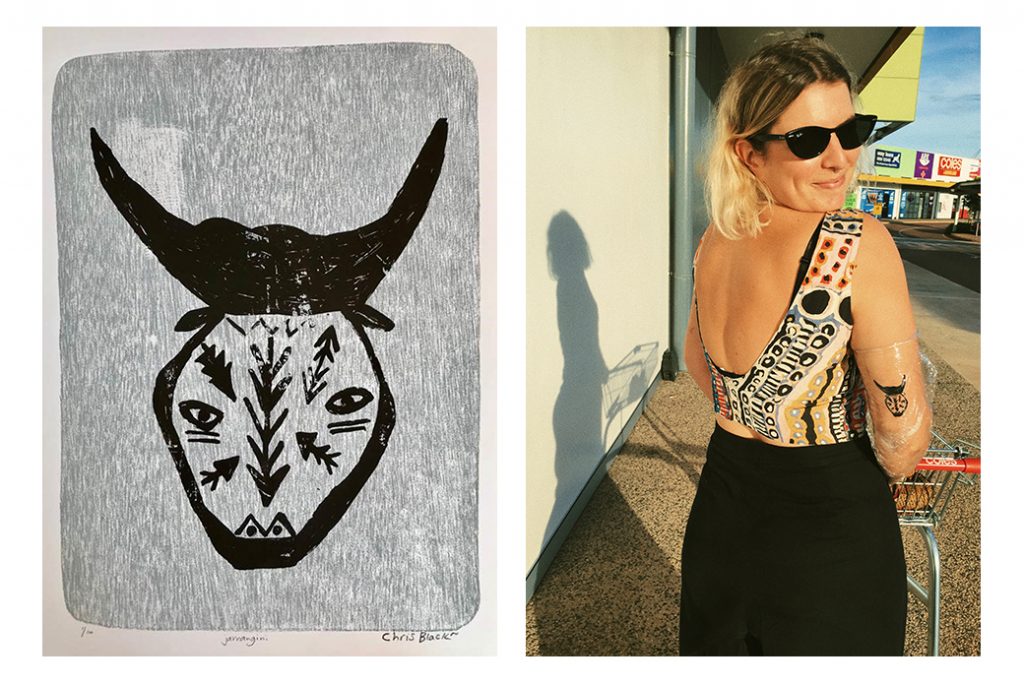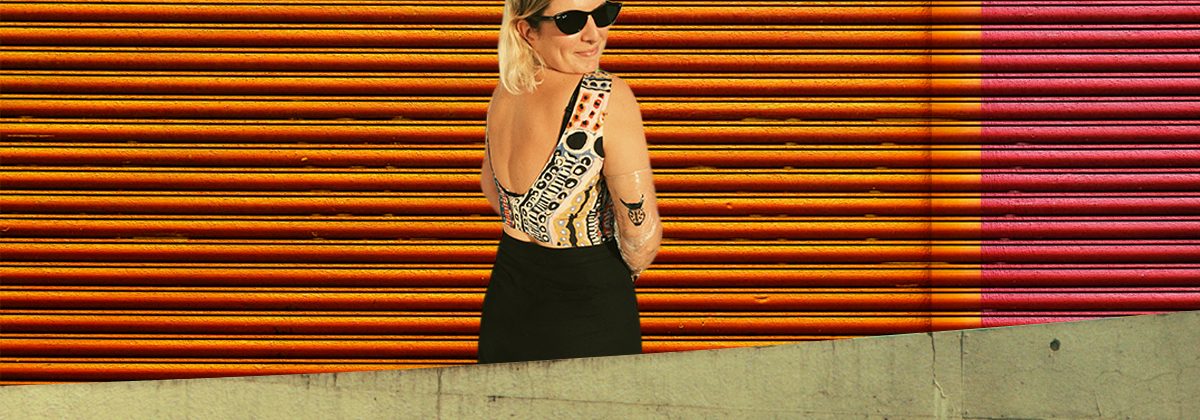Tattoo licence brings new meaning to the term “body art”
June 10, 2020
In a first-of-its-kind arrangement, Copyright Agency has licensed an artwork for a tattoo!
The artwork is by Indigenous artist Chris Black, who works out of Jilamara Arts and Crafts Association in Milikapiti Community on the Tiwi Islands. Jarrangini (buffalo) (2018) is a screenprint depicting the head of a buffalo, which was introduced to the Tiwi Islands by British colonisers in the 1800s and has since become a food source for the Tiwi people.
Katie Hagebols – the manager of Kakadu National Park’s Marrawuddi Gallery, and a tattoo enthusiast – came across the artwork on Jilamara’s website.
“I’d been thinking about getting a tattoo that was significant to the Northern Territory for a while,” explains Katie, who has lived and worked in remote Aboriginal communities for many years. “When I saw Chris’ buffalo print, I fell in love. I knew it would be sensational as a tattoo.”
Working in the industry (and being an artist herself), Katie knew she needed to seek permission to licence the artwork, so she reached out to Jilamara’s manager, Hannah Raisin.
“We were all really excited when Katie contacted us with the request – it’s a first for us,” Hannah says. “A lot of Tiwi artwork is based on jilamara (ceremonial body painting design) and also minga (more permanent cultural skin marking through a person’s life). So there’s something really simpatico about a Tiwi work being tattooed on the skin.”
By all accounts, the artist was “pretty chuffed” with the idea. “At first Chris laughed a lot and thought it was kind of wacky,” Hannah reports, “but he is very open minded and was very much on board.” After a lengthy discussion about the complexities of the proposal, Jilamara brought the Copyright Agency on board to ensure that the new licence covered all bases.
The lifelong and identifying nature of tattoos raised some unique questions. Chris was interested in where the tattoo would be located and how many times it could be reproduced (once, on the back of Katie’s arm). Other senior artists were invited to contribute to the discussion, so the team could take stock of important cultural considerations.
There was also the question of which tattoo artist would be chosen to reproduce Chris’ work. The answer was Ryan Birkinshaw from Darwin Custom Tattoos: Katie’s favourite. “I wholeheartedly trusted him to execute Chris’ design perfectly,” she says. “He made sure I had the correct licensing and that I had gone down the right channels before I made the appointment.”

Left: Chris Black’s Jarrangini (buffalo), 2018 © Chris Black/Copyright Agency, 2020. Right: Photo courtesy of Katie Hagebols.
The resulting one-of-a-kind tattoo is a faithful homage to Chris’ art. “I’m so thrilled with how it turned out,” Katie says. “I believe I’m the first to go through this process, but it was seamless – and I’ve wound up with a divine piece of art that I can cherish forever!”
Hannah agrees that it was a fruitful experience for all involved. “It’s fantastic when people get in touch with exciting new ideas,” she says. “Recently there has been so much bad press about fake art and artists not getting acknowledged for their work. Being part of the tattoo licencing agreement was quite inspiring.
“We were really pleased to bring the Copyright Agency into the conversation and call upon their expertise.”
Could more tattoo licences be on the horizon? It’s certainly a possibility for Chris, says Hannah: “Now he jokes about everyone getting tattoos of his work. He is thinking of expanding the idea into an exhibition later this year… but you’ll have to stay tuned for more info on that!”
And for other tattoo enthusiasts considering taking the plunge into a new kind of body art, Katie encourages them to seek out a licence so that the artist is respected and fairly compensated.
“I really hope this is the start of something new,” she says, “and gives Indigenous artists other ideas for work and income streams.”

